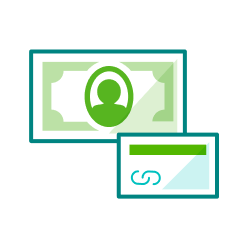Record a returned payment or bounced check
by Intuit•896• Updated about 18 hours ago
If a customer's check bounces in QuickBooks Online, you can record an expense to balance your accounts. Then you attach the bounced check to the original invoice and send it back to the customer, along with a second invoice for any added bank fees.
 Check out QuickBooks Payments rates and apply. Then, you can automatically process payments, deposit funds and record transactions in your books.
Check out QuickBooks Payments rates and apply. Then, you can automatically process payments, deposit funds and record transactions in your books.
Note: If you don’t want to expense the bounced check, you can record it with a journal entry.
Note: If you want help with this process, reach out to your accountant. This can get tricky and they know how to handle the next steps. Don't have an accountant? We can help you find one.
What you’ll need
- The amount of the customer’s check deducted from your bank balance.
- The amount your bank charged you in fees.
- A service item in QuickBooks for any bank fees you plan to charge your customer.
Record the bounced check expense
Create an expense to account for the money deducted from your bank account by the returned check.
- Go to All apps
 , then Accounting, then Bank transactions (Take me there).
, then Accounting, then Bank transactions (Take me there). - Find the bounced check or returned payment on the Reviewed tab.
- Select the transaction to expand the details.
- From the Vendor/Customer ▼ dropdown, select the customer whose payment bounced.
- From the Account ▼ dropdown, select Accounts Receivable.
- Select Add.
Remove the payment from the original invoice
Next, add the bounced check to the expense you just created. This will open the original invoice again.
- Follow this link to complete the steps in product
- Find and select the name of the customer whose payment bounced.
- Find the payment transaction for the bounced check and select Edit.
- Select the payment made link.
- Clear the checkbox for the original invoice the payment was applied to.
- Select the checkbox for the new expense you created in the previous step.
- Select Save and close.
- A message will appear stating that the transaction is linked to others. Select Yes.
Invoice the customer for bank fees
- Select + Create.
- Under Customers, select Invoice.
- From the Add customer ▼ dropdown, select the customer whose payment bounced.
- Set the Invoice date to the day the bank charged you the fees.
- In the Product/service column, select the service item you created for bank fees.
- Enter the amount you want to charge the customer.
- Select Save and close.
Results
Your accounts now reflect the returned payment, and the original invoice has been reopened.
Next steps
Send your customer a Balance Forward statement to show them what they owe. This statement includes both the original unpaid invoice, and the new invoice for bank fees. When the customer pays, you can record the payment as you normally would.
Related links
- Add product and service items
- Record a returned or bounced customer check using a journal entry
- Enter and manage expenses
- Create and send customer statements in QuickBooks Online
- What to do if your check bounces and your bank account has non-sufficient funds
- Record invoice payments
- Add an account to your chart of accounts in QuickBooks Online
More like this